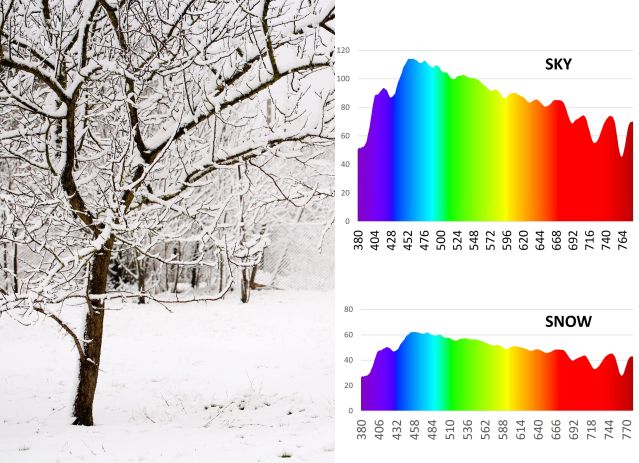Circadian Rhythm
Snow Isn't Really White. Here's Why That Matters.
We can't tell because our perception deceives us.
Posted March 4, 2024 Reviewed by Hara Estroff Marano
Key points
- The color we perceive is very different from the colors in light that impact our health.
- We cannot readily tell whether a light source is healthy or unhealthy because our perception deceives us.
- Snow appears white because it is a faithful reflector of the full daylight spectrum.
The colors we perceive and the colors that impact our health are not the same. Without thinking, we tend to make decisions about the color of light and our surroundings based on what we perceive. But the colors that our bodies react to, and that modulate our physiological functions, can be quite different from what we perceive, and the differences are not readily apparent.
Take, for example, snow. If we examine the color of the light wavelengths entering our eyes on a snowy day, none of them are white. Light reflected off snow contains every color of the rainbow. It is particularly rich in blue, blue-violet, green, yellow, orange, and red.

The sky may be grey, but it has the same distribution of color wavelengths because snow is an excellent reflector of every light color wavelength. The intensity of the light reflected from snow is about 50 percent of every wavelength arriving from the sky. It is that perfect balance of wavelengths that makes the snow appear white.
This matters because our perception of color does not enable us to judge whether the light we see is good for our health. For example, the sky-blue wavelengths in light are the key signal that keeps our circadian rhythms—the 24-hour cycles in virtually every body function—in sync with natural day and night.
Blue-detecting receptors in the retina, containing the photopigment melanopsin, inform our master circadian clock in the brain when they are bathed in blue-rich light. This tells our circadian clock it is daytime. But when no blue light is detected, this is interpreted as night, so that melatonin can be released and sleep can occur.
We mostly live indoors under illumination levels that are far dimmer than the outdoor world during the day and far brighter during nocturnal hours. We cannot easily tell whether the electric lights we use are rich in blue wavelengths and, therefore, harmful for sleep in the evening hours or are weak in blue wavelengths and, therefore, not healthy for daytime use. The percentage of blue content and the intensity of the light entering your eyes are both vital to know before you select a light.
Each of the other wavelengths in the visible natural light spectrum (ranging from 380 nm to 780 nm) serves different functions. Violet light at around 405 nm is a powerful disinfectant, killing viruses and bacteria. Blue light at 460 nm reverses jaundice in newborn babies. Green light around 550 nm maximizes visual brightness perception, relaxes the amygdala, and also mitigates migraines and other pain. Red light at 670 nm promotes cell repair and wound healing. It also stimulates hair growth and reverses diabetic elevations in blood glucose.
Winter is almost over. Take every opportunity you can to go for a daily walk in the snow, even if the sky is grey, for this will bathe you in the bountiful, healthy, blue-rich light beloved by our circadian clocks. It will also dose you with the green wavelengths that sooth the amygdala, and the red wavelengths that heal us. You will perceive the snow as white, but you now know that it is rich in the colors of healthy light.
Facebook/LinkedIn image: CandyRetriever/Shutterstock
References
Article originally published on Substack.


